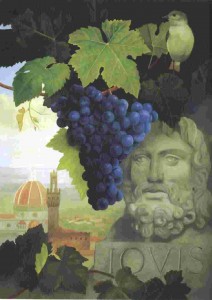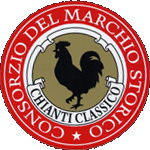by Lorri | May 11, 2011 | UnCorked
 Last week’s column on the story of the Chianti Classico rooster was just the beginning of my exploration of the colossal offerings of the prolific Italian wine region.
Last week’s column on the story of the Chianti Classico rooster was just the beginning of my exploration of the colossal offerings of the prolific Italian wine region.
With more than 27 percent of the region’s sales occurring in the United States, you would expect U.S. consumers to have a good understanding of this region.
There is some confusion, though, likely the result of the sheer immensity of Italian wine offerings.
The primary grape of the Chianti region is the sangiovese, which flourishes on the Tuscan hillsides between Florence and Siena.
Chianti Classico must contain a minimum 80 percent sangiovese, and during my visit many Chianti producers expressed a shift to 100 percent — known as “pure” — to truly showcase the spirit of the sangiovese grape. Other grapes, such as the local canaiolo and colorino or cabernet sauvignon and merlot, can be added. Traditionally the white grapes trebbiano and malvasia were used, but since 2006 they are no longer allowed.
Chianti Classico wines have two distinct styles: the Vintage Year (annual) and Riserva (reserve). The vintage year is a fresh, fruity wine meant to be consumed young. A riserva is much different and strikes a balance between elegance and potency. Riserva wines are aged to provide the finest expression of sangiovese with its full-bodied, complex style. To qualify as a riserva, strict standards must be met, including a minimum of 12.5 percent alcohol, maturation for a minimum of 24 months with at least 3 months in the bottle before going to market.
THE VALUES
- 2008 Castello di Monastero Chianti Classico, Italy (about $24 retail)
- 2008 San Jacopo Chianti Classico, Italy (about $21 retail)
- 2009 Banfi Chianti Classico, Italy (about $15 retail)
- 2008 Cecchi Chianti Classico, Italy (about $18 retail)
THE SPLURGES
- 2008 Villa Antinori Peppoli Chianti Classico, Italy (about $32 retail)
- 2008 Dievole Chianti Classico Riserva, Italy (about $64 retail)
- 2008 Melini Terrarossa Laborel Chianti Classico Riserva, Italy (about $32 retail)
by Lorri | May 4, 2011 | UnCorked
 Just home from Italy with pages of notes and findings, I aim over the next few weeks to offer helpful information about the sometimes confusing and misunderstood Chianti Classico region.
Just home from Italy with pages of notes and findings, I aim over the next few weeks to offer helpful information about the sometimes confusing and misunderstood Chianti Classico region.
A question I’m often asked is, “What does the black rooster on the neck of the bottle represent?”
It denotes that a company is a member of the Consorzio Vino Chianti Classico. That consortium’s mission is protecting, overseeing and maintaining the prices of the Chianti Classico denomination. Exactly how the rooster was chosen comes with a legend.
In the Middle Ages, when the republics of Florence and Siena were fiercely battling for territory in the Chianti region, they came up with a novel method to end that exhausting conflict. It was agreed that two knights would set out from their respective cities and establish the border wherever they met. Departure was to be at dawn and the starting signal at each end would be a cock’s crow.
In those days, daily rhythms were still paced by natural phenomena, so the choice of rooster would be more crucial than either knight or steed. The Sienese chose a white rooster, the Florentines a black one, which they kept in a pen in the dark with no food for days, putting the poor thing in high distress.
On the day of departure, as soon as the black rooster was released from its prison, it began to crow long before dawn. The Florentine knight departed immediately while the Sienese rider had to wait until dawn, when his white rooster crowed.
The Sienese knight rode only about 7 1/2 miles before meeting the Florentine knight far short of the halfway point between Siena and Florence.
Thus, thanks to the black rooster, practically all of Chianti came under the control of the Florentine republic. And thus the emblem of the black rooster on Chianti Classico labels.
THE VALUES
- 2009 Cecchi Chianti Classico, Italy (about $14 retail)
- 2009 Straccali Chianti Classico, Italy (about $14 retail)
THE SPLURGES
- 2009 Castello D’Albola Chianti Classico, Italy (about $19 retail)
- 2009 Rocca Delle Macie Chianti Classico, Italy (about $28 retail)
- 2009 Piccini Chianti Classico, Italy (about $19 retail)
by Lorri | Apr 21, 2011 | Lorri's Wine Diary
 I am taking notes furiously and can’t wait to share them from this trip. A fun piece of wine trivia to get us started is about the “black rooster” on labels from the Chianti Classico wines. I was always told the practical and political reasons behind the labeling but loved hearing the legend from the poised accent of an Italian winemaker.
I am taking notes furiously and can’t wait to share them from this trip. A fun piece of wine trivia to get us started is about the “black rooster” on labels from the Chianti Classico wines. I was always told the practical and political reasons behind the labeling but loved hearing the legend from the poised accent of an Italian winemaker.
In the middle ages, when the republics of Florence and Siena were fiercely battling for territory between Chianti they constructed a bizarre method to end this continuous conflict. It was agreed that two knights would set out from their respective cities and establish the border where they would meet. Departure was to be at dawn and the starting signal given by a cock’s crow. A coherent decision at the time, when daily rhythms were still paced by natural phenomena. And so the choice of rooster would be more decisive to event preparations than either knight or steed. The Sienese chose a white one, the Florentines a black, which they kept in a pen in the dark with no food for days, where the poor thing obviously was in a panic.
On the fateful day of departure, as soon as the black rooster was released from its prison it began to crow, long before dawn. Its crowing allowed the Florentine knight the advantage to depart immediately while the Sienese had to wait until dawn when his white rooster would crow signaling his departure. He only rode about 7 ½ miles before meeting the Florentine knight very quickly.
It was because of the black rooster legend all of Chianti came under the control of the Florentine republic… and of course a well told story behind the emblem of the black rooster on Chianti Classico labels.
by Lorri | Apr 20, 2011 | Lorri's Wine Diary
Today, I am sitting in Italy typing my blog, embarking on a wine journey because of something I read a year ago. It was Matt Kramer’s Wine Spectator column, Are you Afraid of Italian Wines? A shocking confession: Even the experts find the country’s wines daunting. Why I’m here is because I agree.
The columns focus is around he and a fellow wine writer talking shop. When the conversation leads to a very blunt and truthful statement by his friend and an agreement by most of the wine drinkers in the world including myself. “ I’m afraid of Italian wines. It’s not that I don’t’ like them,” he said. “It’s just that they’re so damned complicated. When I first started with wine, everybody told me how difficult Burgundy is how mastering Burgundy could be a life’s work. I’ll tell you one thing: Burgundy is a breeze compared to Italian wines. “ He continued with, “Italian wines seem chaotic. I hate it when I get handed the wine list in an Italian resturant, I’m supposed to know all this stuff about wine, but it’s any kind of extensive Italian wine list I’m lost. . I’m clueless. That’s why I’m afraid of Italian wines.”
So, thus sets out my journey in Italy to better grasp just one region at a time. I will begin this chaos deciphering in Chianti and will offer cliff notes along the way.
 Last week’s column on the story of the Chianti Classico rooster was just the beginning of my exploration of the colossal offerings of the prolific Italian wine region.
Last week’s column on the story of the Chianti Classico rooster was just the beginning of my exploration of the colossal offerings of the prolific Italian wine region. Just home from Italy with pages of notes and findings, I aim over the next few weeks to offer helpful information about the sometimes confusing and misunderstood Chianti Classico region.
Just home from Italy with pages of notes and findings, I aim over the next few weeks to offer helpful information about the sometimes confusing and misunderstood Chianti Classico region.